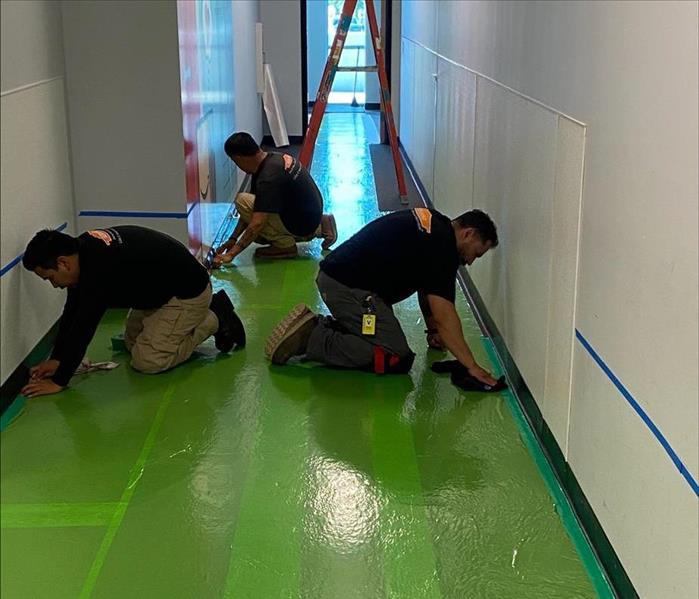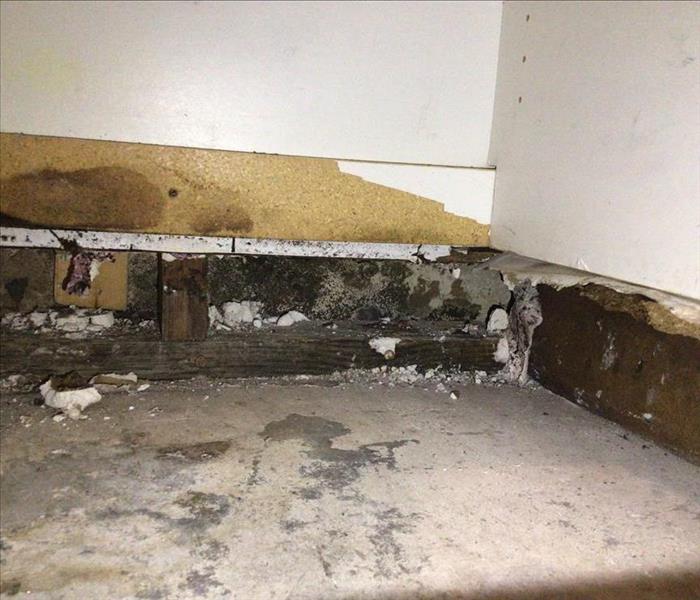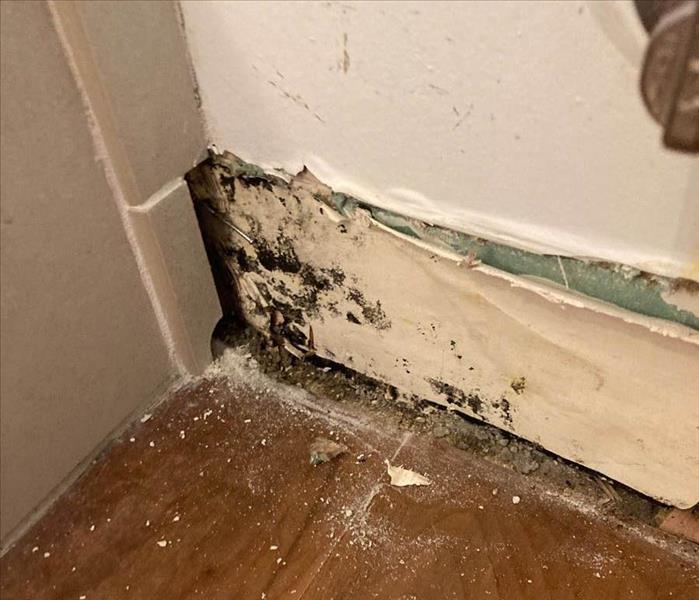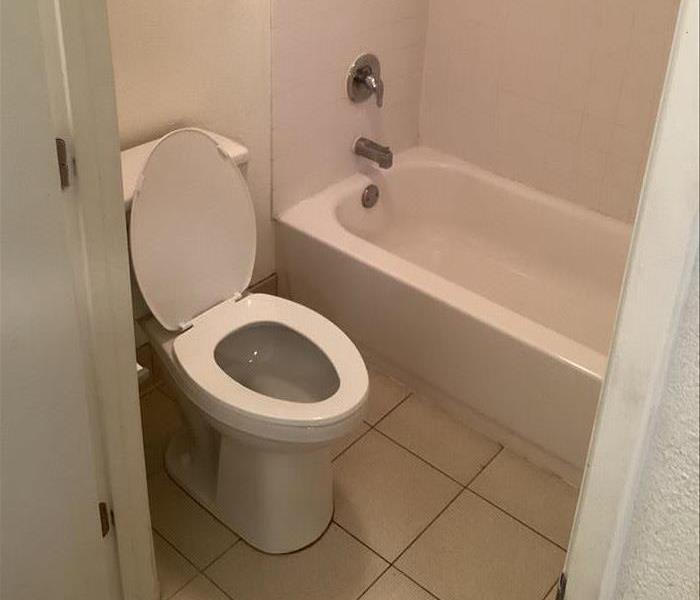Recent Mold Remediation Posts
Refrigerant vs. Desiccant: Key Differences in Climate Control Solutions
10/16/2024 (Permalink)
 This blog delves into the critical distinctions between refrigerant and desiccant systems, drawing on expert insights.
This blog delves into the critical distinctions between refrigerant and desiccant systems, drawing on expert insights.
When it comes to maintaining optimal humidity and temperature conditions in commercial or industrial spaces, businesses often face the choice between refrigerant and desiccant dehumidification systems. Both methods are effective for different applications, but understanding the key differences can help in making an informed decision. This blog delves into the critical distinctions between refrigerant and desiccant systems, drawing on expert insights to help you determine which is best suited for your needs.
What Is a Refrigerant Dehumidifier?
Refrigerant dehumidifiers, also known as compressor dehumidifiers, operate on the same principle as air conditioners. They work by drawing moist air over a cooled coil, which causes the moisture in the air to condense into water. The collected water is then drained away, and the drier air is released back into the space.
This type of dehumidifier is particularly effective in warm, humid environments. Because the cooling coil needs to be significantly colder than the air temperature, refrigerant dehumidifiers work best in environments with temperatures above 65°F (18°C). They are widely used in residential settings and for general humidity control in commercial spaces.
Key Benefits of Refrigerant Dehumidifiers:
- Cost-effective for general humidity control
- Best suited for warm environments
- Relatively low maintenance
- High capacity for moisture removal in ideal conditions
One of the notable strengths of refrigerant dehumidifiers is their efficiency in warm climates. However, their effectiveness drops in cooler environments where moisture doesn't condense as easily.
What Is a Desiccant Dehumidifier?
Desiccant dehumidifiers use a completely different method to remove moisture from the air. Instead of cooling the air to condense water, desiccant systems rely on hygroscopic materials like silica gel to absorb moisture. The moisture-laden air passes through a rotor filled with desiccant material, which traps water molecules. The collected moisture is then heated and expelled through an exhaust system.
This makes desiccant dehumidifiers highly effective in low-temperature environments where refrigerant systems struggle. They are often used in industrial applications, cold storage, and spaces that require precise humidity control, such as museums and pharmaceutical manufacturing facilities.
Key Benefits of Desiccant Dehumidifiers:
- Effective in cold and low-temperature environments
- Ideal for applications requiring very low humidity levels
- Can operate in sub-zero conditions
- Durable with a long lifespan
One significant advantage of desiccant dehumidifiers is their ability to maintain performance in colder settings. Unlike refrigerant models, they are not dependent on temperature differentials to extract moisture, making them more versatile across a broader range of environmental conditions.
Comparing Refrigerant and Desiccant Dehumidifiers
While both types of dehumidifiers serve the same basic function—removing moisture from the air—the methods they use make them suited to different applications. Here’s a breakdown of their key differences:
- Operating Principle: Refrigerant dehumidifiers use condensation, while desiccant dehumidifiers absorb moisture through a hygroscopic material.
- Best Use Cases: Refrigerant systems excel in warm environments, whereas desiccant systems are better for cold or low-humidity applications.
- Energy Efficiency: Refrigerant dehumidifiers are generally more energy-efficient in warm climates, but desiccant systems can be more efficient in colder environments.
- Maintenance Needs: Refrigerant systems require regular cleaning of coils and drainage, while desiccant systems need periodic replacement of the desiccant material.
One statistic highlights the importance of selecting the right dehumidification method: The global demand for desiccant dehumidifiers is projected to grow at a compound annual growth rate (CAGR) of 7.5% from 2020 to 2027, driven by increasing adoption in industrial sectors.
Choosing the Right System for Your Needs
Selecting between a refrigerant and desiccant dehumidifier ultimately comes down to your specific needs:
- Climate: For warmer climates, refrigerant systems are typically more cost-effective and efficient.
- Application: For cold storage or industrial applications requiring low humidity, desiccant systems are the better option.
- Energy Considerations: Consider the long-term energy costs based on the environmental conditions in which the system will operate.
Conclusion
Understanding the key differences between refrigerant and desiccant dehumidifiers can help you make a more informed decision for your specific humidity control needs. While refrigerant dehumidifiers are ideal for general residential or commercial use in warmer climates, desiccant dehumidifiers offer superior performance in colder environments and specialized industrial applications. By weighing the pros and cons of each system, you can choose the most suitable dehumidification solution for your space.
Safeguarding Your Home: How Mold Impacts Structural Integrity and Solutions for Prevention
10/16/2024 (Permalink)
When left untreated, mold can cause long-term damage to various parts of your property, weakening the materials that make up the framework of your home. Understanding how mold can compromise structural elements and what steps to take can help protect your investment. In this blog, we'll discuss the risks mold poses to your home's structure and how professional services, like SERVPRO®, can help restore and safeguard your property.
How Does Mold Affect Your Home's Structure?
Mold thrives in damp, dark environments, making areas like basements, attics, and behind walls particularly vulnerable. While mold spores are naturally present in the air, they require moisture to grow. Once mold establishes itself, it can begin to feed on organic materials such as wood, drywall, and insulation—key components of your home’s structure.
- Wood Decay: Mold can break down wood fibers, which weakens structural supports like beams, floorboards, and wall studs. Over time, this can lead to warping, cracking, or even collapsing of these critical elements.
- Drywall Damage: Mold can spread across drywall, causing it to become brittle and lose its structural integrity. Damaged drywall may need to be completely replaced if mold has compromised it beyond repair.
- Insulation Issues: Mold can infiltrate insulation materials like fiberglass or foam. Once mold grows in these materials, their effectiveness is compromised, leading to reduced energy efficiency in your home. This can also increase the cost of repairs, as insulation may need to be removed and replaced.
- Foundation and Floor Damage: Mold that grows in basements or crawl spaces can also damage concrete foundations or floor joists. While concrete is less prone to mold damage than wood, the moisture that allows mold to grow can also contribute to cracks and deterioration in your foundation.
Signs That Mold May Be Affecting Your Home's Structure
One of the tricky aspects of mold damage is that it often goes unnoticed until the problem has worsened. Mold can thrive in hidden places, behind walls, under floors, or in poorly ventilated spaces like attics and basements. Keep an eye out for these signs:
- Visible Mold Growth: If you see mold growing on walls, floors, or ceilings, this is a strong indication of a larger issue.
- Musty Odors: Mold produces a distinct, musty smell that often signals hidden growth.
- Discoloration and Staining: Water stains or discoloration on walls or ceilings can indicate moisture problems that are ideal conditions for mold growth.
- Warped or Buckling Floors/Walls: If floors or walls appear to warp or buckle, this can suggest moisture and mold issues behind the surface.
SERVPRO’s Role in Mold Remediation and Structural Protection
Mold remediation isn’t just about removing surface-level growth; it requires addressing the root cause of the moisture and thoroughly treating affected areas to prevent recurrence. SERVPRO specializes in mold remediation services that go beyond cleaning visible mold. With advanced tools and techniques, SERVPRO can assess the extent of the damage, remove contaminated materials, and dry the affected areas to halt mold growth.
SERVPRO also helps restore the structural integrity of your home by removing damaged building materials like drywall and insulation, replacing them with fresh materials. Additionally, professionals will advise on moisture control measures, such as improved ventilation or fixing leaks, to prevent future mold growth.
Protecting Your Home from Structural Mold Damage
The best way to prevent mold from damaging your home’s structure is to stay vigilant and address any moisture issues immediately. Whether it’s a slow leak, poor ventilation, or flooding, taking quick action can prevent mold from taking hold.
If you suspect mold or have already noticed damage, contact SERVPRO of South Redlands/Yucaipa/North Riverside City/Big Bear/Lake Arrowhead/NE Rancho Cucamonga for expert mold remediation and restoration services.
By addressing mold early and seeking professional help, you can preserve the strength and stability of your home for years to come.
Pets and Mold: Protecting Your Furry Friend
7/17/2024 (Permalink)
As pet owners, we know how important it is to keep our furry friends safe and comfortable. One often overlooked threat to their well-being is mold. Mold can grow in any home and thrive in damp, humid environments, posing a risk to our pets. At SERVPRO®, we understand the importance of maintaining a mold-free home, not just for your family but also for your pets. Here are some tips and insights on how to protect your furry friends from mold.
Understanding Mold Growth
Mold spores are everywhere, but they only become a problem when they find a suitable environment to grow. Moisture is the key ingredient for mold growth. Common places where mold can develop include basements, bathrooms, kitchens, and areas around leaky windows or roofs. Mold can also thrive in pet areas, such as near water bowls, in aquariums, or in spaces where pets might have accidents.
Preventing Mold in Pet Areas
- Keep Pet Areas Dry: Ensure that any areas where your pets spend time are kept dry and well-ventilated. This includes spaces where they eat, sleep, and play. Use a dehumidifier in damp areas and fix any leaks promptly to prevent moisture buildup.
- Regular Cleaning: Regularly clean your pet’s bedding, toys, and feeding areas. Use washable materials for pet beds and blankets, and wash them frequently in hot water to kill any mold spores.
- Control Humidity: Keep indoor humidity levels below 60% by using air conditioners or dehumidifiers. You can also use exhaust fans in bathrooms and kitchens to reduce moisture.
- Aquarium Care: If you have an aquarium, ensure it is properly maintained. Regularly clean the tank and ensure it has a good filtration system to prevent mold growth.
Detecting Mold Early
It's essential to detect mold early to prevent it from spreading. Look for visible signs of mold, such as black or green spots on walls, ceilings, or floors. Mold can also have a musty odor, which can be a telltale sign of its presence. If you suspect mold, it’s crucial to address it immediately.
Professional Mold Remediation
While small mold issues can sometimes be handled with proper cleaning, larger mold problems require professional intervention. SERVPRO offers expert mold remediation services to ensure your home is thoroughly cleaned and safe for both your family and pets. Our team uses advanced equipment and techniques to detect and eliminate mold, ensuring it doesn’t return.
Creating a Mold-Free Environment
Maintaining a mold-free environment is a continuous process. Regular home inspections, proper ventilation, and immediate attention to moisture issues are key steps in preventing mold growth. By taking these proactive measures, you can protect your pets from the risks associated with mold and ensure they remain happy and healthy in a safe home environment.
Your pets rely on you for their safety and comfort. By understanding the risks of mold and taking steps to prevent its growth, you can create a healthier living space for your furry friends. Remember, if you ever encounter a mold problem that's too big to handle on your own, SERVPRO is here to help with professional mold remediation services. Together, we can ensure a mold-free home for you and your pets.
A Guide to Removing Mold from Home Insulation
3/12/2024 (Permalink)
 In this blog, we'll provide you with a practical guide on how to effectively remove mold from home insulation without unnecessary fuss.
In this blog, we'll provide you with a practical guide on how to effectively remove mold from home insulation without unnecessary fuss.
Discovering mold in your home insulation can be a cause for concern, but rest assured, addressing the issue is a manageable task. Mold in insulation often occurs in areas with high humidity or water damage, and taking prompt action is crucial. In this blog, we'll provide you with a practical guide on how to effectively remove mold from home insulation without unnecessary fuss.
1. Identify the Affected Area
Begin by identifying the areas of insulation that show signs of mold growth. Look for discoloration, a musty odor, or visible mold patches on the insulation material.
2. Gather Your Supplies
Before diving into the removal process, gather the necessary supplies. You'll need protective gear such as gloves, a mask, and safety glasses. Additionally, have garbage bags, a vacuum cleaner with a HEPA filter, and a stiff brush or sponge ready.
3. Isolate the Area
To prevent the spread of mold spores to other parts of your home, isolate the affected area. Seal off the space with plastic sheeting and tape, creating a containment zone for the removal process.
4. Remove and Discard Moldy Insulation
Carefully remove the mold-affected insulation from the area. Place the insulation directly into garbage bags, sealing them tightly. This ensures that mold spores are contained and don't spread during disposal.
5. Clean the Area
Thoroughly clean the area from which you removed the insulation. Use a stiff brush or sponge along with appropriate cleaning products to scrub the surfaces. This helps remove any remaining mold spores or residues.
6. Vacuum with HEPA Filter
Use a vacuum cleaner equipped with a HEPA filter to carefully vacuum the entire space, including the floor and surrounding surfaces. This helps capture and trap any airborne mold spores, preventing them from spreading.
7. Replace with Mold-Resistant Insulation
After completing the cleaning process, it's time to replace the removed insulation. Consider using mold-resistant insulation materials to minimize the risk of future mold growth. This is particularly important in areas prone to moisture.
8. Address the Source of Moisture
To prevent mold from returning, identify and address the source of moisture. Whether it's a leak, water intrusion, or high humidity, resolving the underlying issue is crucial for long-term mold prevention.
9. Monitor for Recurrence
Keep an eye on the treated area for any signs of mold recurrence. Regular inspections and maintaining a dry environment will help ensure that your efforts in mold removal and prevention are effective.
By following these practical steps, you can successfully remove mold from home insulation and create a healthier indoor environment. Remember, a proactive approach and addressing moisture issues are key to keeping mold at bay.
Mold Prevention Strategies for Seasonal Properties: Keeping Your Vacation Home Mold-Free
11/7/2023 (Permalink)
Vacation homes provide a much-needed escape for relaxation and enjoyment, but they can also be susceptible to mold growth, particularly during periods of vacancy. In this blog, we will explore practical strategies for preventing mold in seasonal properties, ensuring a worry-free and pleasant experience.
Moisture Control
One of the key factors contributing to mold growth is excessive moisture. Before closing up your vacation home, thoroughly inspect and repair any leaks or water damage. Properly seal windows and doors to prevent water intrusion during heavy rains or storms. Consider using a dehumidifier or installing a programmable thermostat to maintain optimal humidity levels while the property is unoccupied.
Ventilation
Proper ventilation is vital in preventing mold growth in seasonal properties. Ensure that your vacation home has adequate airflow by opening windows or utilizing exhaust fans. Consider installing a mechanical ventilation system or a timer-controlled fan to promote air circulation and prevent condensation in enclosed spaces.
Regular Inspections
Routine inspections are crucial for detecting and addressing potential mold issues before they become major problems. Schedule periodic visits to your vacation home to inspect for signs of water leaks, musty odors, or visible mold growth. Pay extra attention to areas prone to moisture accumulation, such as basements, bathrooms, and kitchens. Promptly address any signs of moisture or mold to prevent further spread.
Furniture and Belongings Storage
Proper storage of furniture and belongings can help prevent mold growth during the off-season. Before closing up your vacation home, thoroughly clean and dry all items. Remove cushions, mattresses, and upholstery, allowing them to breathe and avoiding potential moisture retention. Consider using moisture-absorbing products, such as silica gel packs or desiccant bags, to help control humidity levels within storage areas.
Professional Assistance
In some cases, seeking professional assistance may be necessary to prevent and address mold issues in your seasonal property. Certified mold inspectors can provide thorough assessments, identifying moisture sources and recommending preventive measures. Mold remediation professionals can effectively remove mold and provide guidance on long-term prevention strategies.
Protecting your vacation home from mold growth requires proper moisture control, ventilation, regular inspections, and careful storage of belongings. By implementing these preventive strategies, you can ensure that your seasonal property remains mold-free, providing you and your loved ones with a safe and enjoyable retreat away from home.
Say Goodbye to Mold: A Guide to Cleaning Up Small Amounts of Mold in Your Home
5/9/2023 (Permalink)
Mold is a type of fungus that grows on organic material, such as wood and food. It's usually found in damp places like basements or bathrooms, but it can also grow on drywall if you have a leaky pipe in your home.
Where is Mold Found?
Mold can grow in many places, including bathrooms, kitchens, basements and crawl spaces. The humidity from a shower or bath can provide the perfect conditions for mold to flourish. If you have an open window and don't use your kitchen fan, the air will get stagnant and allow mold to grow on surfaces like countertops and cupboards (especially if they're made of wood). Basements or crawl spaces with poor ventilation, which allows moisture to build up and create an ideal environment for mold growth.
How to Clean Up Small Amounts of Mold
The first step to cleaning up mold is figuring out how much of it you have. If you have a large amount, or if the area has been closed off for some time, then it's best to call in professionals who have experience dealing with mold.
If you do decide to clean up small amounts of mold yourself, follow these steps:
Wear protective gear, a respirator mask and gloves are recommended. Remove all items from the area that can be cleaned without damaging them (this includes carpeting). If possible, remove drywall as well, otherwise vacuum thoroughly after removing any visible growths. If there are any large pieces remaining on the surface after vacuuming them off (like wallpaper), scrape these away using a putty knife or similar tool so that they don't come back later when new growth occurs beneath them Wash down all surfaces with water mixed with bleach at least twice, once after removing visible growths and again after vacuuming up dust particles left behind by your cleaning methods. Let everything dry completely before replacing furniture or other objects back into place.
How to Prevent Mold Growth
Humidity control. If you have a humidifier, make sure it's working properly and not leaking water into your home. Also be sure to keep the bathroom fan on when showering or bathing to prevent excess moisture from building up in the air. Ventilation, Open windows when possible, especially during warmer months when humidity levels tend to be higher than usual.
Maintenance, Check for leaks around pipe fittings and faucets, repair any leaks immediately if found (a common source of mold growth).
What to Do If You Suspect a Larger Mold Problem
If you suspect a larger mold problem, it's best to hire a professional. A trained inspector can test for mold and determine whether there is an issue that requires remediation. If so, they will also be able to tell you how much cleaning up needs to be done and how much it will cost.
If you suspect mold in your home or office, give the professionals at SERVPRO a call to immediately assess and begin the mold remediation process for quick cleanup.
Top 3 Locations for Mold Growth in Your Home
1/17/2023 (Permalink)
 To prevent mold damage, it's important to regularly inspect these three spots.
To prevent mold damage, it's important to regularly inspect these three spots.
Mold is a fungus that can grow in the house if you don't take preventive measures. It's common to find mold in basements and attics, as they tend to be humid, but it's also possible that mold could have started growing out of sight. To prevent further damage, it's important to regularly inspect these three spots.
The Attic
The attic may be a good place to start looking for mold. The attic is a dark, damp, and warm place that is ideal for mold growth. Mold spores that are in the air can easily land on surfaces such as wood or insulation in your attic. If you have any leaks or moisture in this area, it will only increase the chances of mold growth.
It’s important that you check your attic regularly so that you can catch any potential issues before they become serious concerns!
The basement
The basement is the most common place for mold growth, and it's not hard to see why. The moisture in your basement often comes from a leaking roof or plumbing leaks, which can ruin your home's structure if left unchecked. Mold growth can also come from the water that gets in through your foundation. If you have a leaky basement, it's important to fix the issue immediately so that mold doesn't start growing inside your home!
Mold caused by condensation on windows or walls can also be found in your basement. Condensation occurs when warm air comes into contact with cold surfaces like windows and walls; this makes the water vapor in the surrounding air condense on those surfaces as it cools down.
The crawlspace
Mold grows in dark, damp areas. Crawlspaces are often dark and damp. Mold can grow on the insulation, wood, and other materials in your crawlspace. Mold may damage your home by rotting wood beams or making it more difficult to sell if you ever decide to move out of it later on down the road.
Regular mold inspection is a preventive measure
It is important to understand that mold can grow anywhere in your house, even in the most unexpected places. It can be difficult to spot and remove because of its microscopic size and hardy nature.
Additional spaces to inspect include:
- Bathroom
- Kitchen
- Air-conditioning system
There are many different places in your house where mold can grow. The most common areas include the bathroom and kitchen. If you’re not checking these areas regularly for mold, then it could be damaging to your property. If you discover a potential mold infestation in your home or business in Redlands, CA, don’t hesitate and give our SERVPRO team a call today!
 This blog delves into the critical distinctions between refrigerant and desiccant systems, drawing on expert insights.
This blog delves into the critical distinctions between refrigerant and desiccant systems, drawing on expert insights.






 24/7 Emergency Service
24/7 Emergency Service


